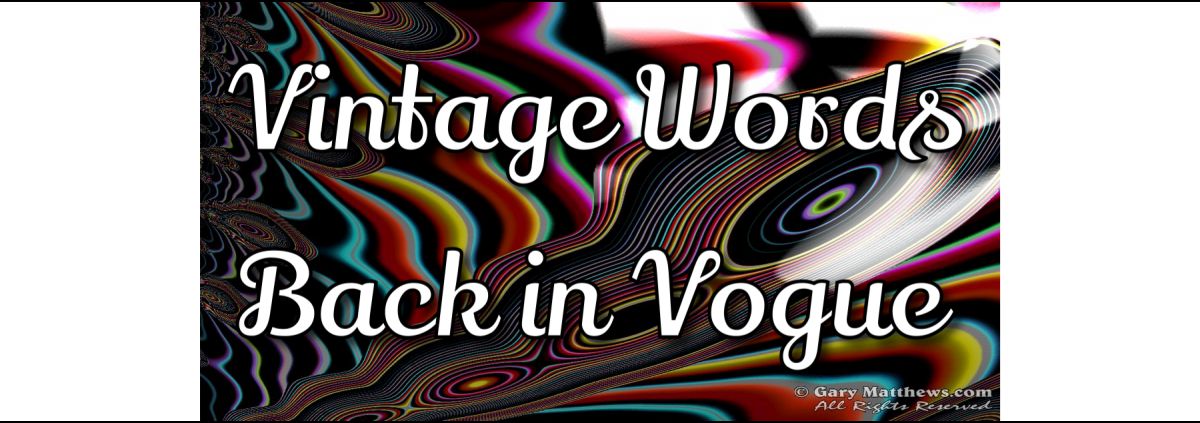Vintage words are making a comeback. (Thanks to Richard Green for spotting an eye-opening article about this.)
Words like “peruse”, “smitten”, “bespoke”, and “dapper” are rising sharply in popularity since year 2000 – the turn of the 21st century.
The same is true of words like “thee”, “thou”, “fortnight”, “bedchamber”, “amongst”, and others that are not just vintage, but downright archaic.
That isn’t to say such words compete yet on an equal footing with Internet slang, emoji, and text-message acronyms like LOL. Compete? No. Coexist? Yes.
This pattern seems first to have been remarked upon by JStor Daily (daily.jstor.org), an ezine that bills itself as the place “where news meets its scholarly match”. Its article (October 13, 2015, by Chi Luu) is titled “More Hipster Than Thou: Is Vintage Language Back in Vogue?”
Sadly, that article, for all its merit, strikes me as one where news meets even more than its scholarly match: I found it turgid and unfocused. The good stuff is all but buried beneath verbose ramblings on the dynamics of nostalgia and hipsterism throughout the ages.
A better read, citing and summarizing the JStor piece, is the one Richard reposted. It’s a 22 October 22 2015 essay by Aria Bendix in Citylab.com: “Vintage Language Is Back in Style”.
Usage patterns were charted using Google’s Ngram viewer, which tracks word frequency in printed literature. (Though the article didn’t say, I’m guessing this happens via the Google Books project, which seeks to scan and digitize all the world’s printed books.)
Details remain sketchy. The findings presented were more in the nature of spot-checks than a comprehensive overview. But they seem indicative – plus, they reinforce impressions I already had gleaned from my own reading.
Here’s my take on it:
An Upsurge of Reading
The big news here isn’t that “vintage words” are on the upswing. It’s that reading – all forms of reading – are on the upswing. The increasing prevalence of traditional terms is a mere symptom of that larger trend.
This isn’t some nostalgia kick. It isn’t the latest hipster fad. Reading is central to modern life. It’s becoming steadily more so.
Not that I think reading was ever in danger of disappearing. Like everything else, it ebbs and flows. Maybe it’s been in decline for a while, and maybe now it’s on an uptick. But I think these minor ups and downs are part of an overall, long-term upward climb.
For years we’ve heard doom-and-gloom about the “death of reading” and the “death of literacy”. We’re told that in a world of Twitter, TV sound bites, and streaming video, books are fading away, and the written word will be no more.
Well, I don’t buy it, and I never did. I hope you don’t buy it either. We’ve been hearing this “no one reads anymore” nonsense all our lives. Our parents and grandparents heard it before we did. It’s been fodder for sensational headlines for as long as anyone can remember.
We heard this while Harry Potter books were flying off the shelves, along with reprints of J.R.R. Tolkien’s “Lord of the Rings” series. We heard it while Stephen Hawking’s “A Brief History of Time” – a science feast hardly for the faint of heart – spent more than 52 freakin’ weeks on the NYT bestseller list. We heard it while we were gobbling up John Grisham, James Patterson, Nora Roberts, Dean Koontz, Twilight, Hunger Games, Oprah’s Book Club, and a lot more.
After 2008, a lot of traditional publishers and bookstores were squeezed by recession, by the unforeseen rise of Amazon, and by digital publishing generally. The famous B. Dalton chain closed its doors in early 2010. Small booksellers were hard-hit, too.
These events prompted more handwringing about the “demise of reading and literary culture”. But it wasn’t that. It was recession, coupled with the time it takes to adapt to new technologies such as Kindles and iPads.
During the so-called “death of reading”, ebooks exploded in popularity, as did self-publishing (both electronic and print-on-demand). It became fair to ask: If reading is dying, why are more writers than ever before finding it possible to earn a living through their writing? Who are these nonexistent readers buying books?
Nowadays, used bookstores are proliferating and thriving, along with indie bookstores and chain outlets. Even Amazon is now opening brick-and-mortar stores.
What’s Different Now
From where I stand, reading never went away – and today it’s more popular then ever. But one thing has changed:
Today, every computer, every phone and tablet can instantly access all the “great classics” ever written. You want to read Twain? Dickens? Austen? Dumas? It’s all there, free, at your fingertips.
(To remind myself how true this is, I just downloaded the “Complete Poems of Emily Dickinson” from Project Gutenberg. I’ve owned the paper version since college, but now I also have it on my iPhone. This means I can read it while waiting in line at the grocery.)
The increasing popularity of vintage words perfectly parallels the increasing availability of vintage books. That’s no accident. It’s a natural result of the same technologies that gave us smileys and selfies.
Perusing these findings, I’m LMFAO – and utterly smitten. Here’s hoping thou art too LOL! ≧◔◡◔≦
(This article is part of my series on words that are #worth1000pictures.)

